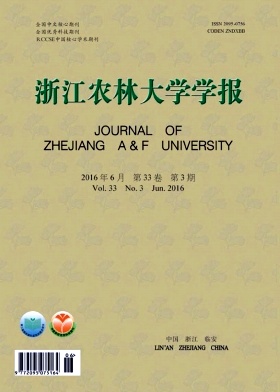-
扦插繁殖是林木苗木培育和无性系育种的重要技术支撑。现有研究表明:插穗来源、留叶方式、生长调节剂、基质和叶面施肥等因素对插穗生根均有重要影响,其影响程度因种而异。虽然扦插繁殖的程序和因素在树种间基本相同,但因素的适宜或最佳水平却因种而异,需要对上述因素进行实验才能得到最优化的数值。米老排Mytilaria laosensis是金缕梅科Hamamelidaceae壳菜果属Mytilaria常绿阔叶大乔木,天然分布于中国广东西部、广西西南部和云南东南部以及越南、老挝北部,适宜生长的土壤为以砂岩、砂页岩、花岗岩等发育成的酸性、微酸性的红壤[1]。米老排是中国南亚热带地区集生态保护、用材和观赏于一身的多用途优良乡土树种[2-3]。自20世纪80年代米老排开始受到林业工作者的关注,然而相比于杉木Cunninghamia lanceolata,桉树Eucalyptus等主要造林树种而言,其培育技术研究相对滞后。在繁殖方面,目前米老排主要依靠有性繁殖,组培繁殖也取得初步成功,但其扦插繁殖技术尚未有研究涉及,扦插繁殖各影响因素的适宜或最佳水平仍不清楚。笔者研究了插穗来源、留叶方式、植物生长调节物质、基质和叶面施肥5个因素对米老排扦插繁殖的影响,对其扦插繁殖技术进行了优化,研究结果可为米老排苗木培育和无性系育种提供实验和技术支撑。
HTML
-
采用完全随机化设计。插穗选用1年生幼苗中上部枝条、5年生树根际当年生萌条中上部分、5年生树中上部当年生枝条3种(以下由幼苗、萌条、枝条依次代表上述3种插穗来源),插穗为60条·来源-1。插穗留1片叶,以2 000.0 mg·L-1的ABT1号10 s速蘸,扦插基质为V(红土):V(泥炭)=1:1的混合基质。于2014年10月12日扦插,同年12月27日取样测定。
-
采用完全随机化设计。设置2种留叶方式,保留1片叶;保留1/2片叶,沿叶片横径方向剪掉半片叶;以不留叶为对照,50条·处理-1。以2 000 mg·L-1的ABT1号10 s速蘸,扦插基质为V(红土):V(泥炭)=1:1的混合基质。于2014年11月16日进行扦插,2015年1月28日取样测定。
-
采用随机完全区组设计,参试植物生长调节物质种类为吲哚乙酸(IAA),吲哚丁酸(IBA),萘乙酸(NAA)和ABT1号生根粉4种,每种植物生长调节物质设置500,1 000,1 500,2 000 mg·L-1等4种质量浓度,以清水为对照,共17个处理。3次重复·处理-1,插穗50根·重复-1。植物生长调节物质处理以后,用石蜡迅速封插穗上下切口。插穗取自1年生幼苗中上部,留1/2片叶,扦插基质为V(泥炭):V(蛭石)=1:1的混合基质。实验于2014年4月16日进行扦插,6月16日取样测定。
-
采用完全随机化设计,参试基质及基质组合(基质组合间比例为体积比)共有9种,分别为红土、泥炭、砂、蛭石,V(泥炭):V(蛭石)=1:1,V(泥炭):V(砂)=1:1,V(红土):V(泥炭)=1:1,V(砂):V(泥炭)=2:1,V(红土):V(泥炭)=2:1,插穗50条·处理-1。插穗取自1年生幼苗中上部,插穗留1/2片叶,植物生长调节物质处理为2 000 mg·L-1的ABT1号10s速蘸。以下V(泥炭):V(蛭石)=1:1,V(泥炭):V(砂)=1:1,V(红土):V(泥炭)=1:1,V(砂):V(泥炭)=2:1,V(红土):V(泥炭)=2:1分别简称为泥蛭1:1,泥砂1:1,土泥1:1,砂泥2:1,土泥2:1。插穗留1/2片叶。实验于2014年9月13日开始,于12月5日取样测定。
-
参试因素为基质种类与植物生长调节物质,采用双因素实验设计。以天然成年大树1年生萌条为材料,以砂、蛭石与V(红土):V(泥炭)=1:1为基质,2 000 mg·L-1ABT1号与600 mg·L-1IBA+400 mg·L-1NAA(以下称为BBT)为植物生长调节物质。插穗取自1年生幼苗中上部,留1片叶,速蘸植物生长调节物质10 s后扦插。插穗16条·处理-1。于2014年12月9日扦插,2015年3月30日取样测定。
-
采用完全随机化实验设计,参试因素为叶面施肥,以不施肥为对照,50条·处理-1。叶面施肥处理中,施用肥料为速效复合肥——质量分数为1.00%的普罗丹复合肥(加拿大植物营养产品公司生产,营养成分质量分数为氮12.00%,五氧化二磷2.00%,氧化钾14.00%,钙6.00%,镁3.00%,硼0.02%,铜0.05%,铁0.05%,锰0.10%,锌0.05%,钼0.05%,乙二胺四乙酸EDTA复合体1.00%),施肥质量浓度为1.0 g·L-1,插后施肥持续30 d,施肥频率为1次·d-1,施用量以喷湿叶面为准。插穗取自1年生幼苗中上部,插穗留1片叶,以2 000 mg·L-1的ABT1号10 s速蘸,扦插基质为V(红土):V(泥炭)=1:1混合基质。于2014年11月16日进行扦插,2015年1月28日取样测定。
-
整个实验在中国林业科学研究院热带林业研究所温室塑料薄膜大棚内进行。扦插容器长×宽×高为540 mm×280 mm×80 mm的育苗穴盘,穴数50个·盘-1。扦插前1 d基质用5.0 g·L-1高锰酸钾溶液淋灌消毒,塑料薄膜覆盖,扦插时再打开。插穗制作好以后用3.0 g·L-1的多菌灵溶液浸泡消毒30 min,取出后用自来水冲洗干净,之后将其下切口端3 cm左右在配制好的生长调节剂溶液中放置10 s后取出扦插。插后每日9:00和14:00打开塑料薄膜大棚,将凋落物与腐烂穗条移出棚外;依照天气状况对其进行增湿降温。扦插初期湿度维持在90%以上,取样前1周维持在70%左右。
-
生根率:用肉眼观测插穗基部是否具有根状物并记录,统计长根的插穗数,将该数乘以100再除以该处理参试插穗总数即为生根率。愈伤率:用肉眼观测插穗基部是否具有愈伤组织并记录,统计具有愈伤组织的插穗数,将该数乘以100再除以该处理参试插穗总数即为愈伤率。宿叶率:用肉眼观测插穗留叶是否存在并记录,统计留叶宿存的插穗数,将该数乘以100再除以该处理参试插穗总数即为宿叶率。新叶数:用肉眼观测数出插穗新萌叶的数量。一级根数:一级根数为插穗上直接长出的根,用肉眼观测统计其数量。第1根点:指下切口到离下切口最远的根着生点的距离,用精度为0.1 cm的直尺测量,精确到0.1 cm。最长根:不定根中长度最长的根,用精度为0.1 cm的直尺测量,精确到0.1 cm。偏根率:插穗表面圆周上没有根分布的部分占整个圆周的比值,记录时以0,0.25,0.50,0.75,1.00来表示,以圆周360°计,0表示360°范围均有根分布,0.25表示270°范围有根分布,0.50表示180°范围有根分布,0.75表示90°范围有根分布,1.00表示只有1~2条根存在。新枝质量:将新枝切下,用精度为0.000 1 g分析天平测量。根质量:将新生根切下,用精度为0.000 1 g分析天平测量。穗条质量:将切去根、新枝后的穗条用精度为万分之一分析天平测量。1.1.3实验的插穗根部在华南农业大学根系生物学研究中心测定,使用根系系统分析软WinRHIZ0-Pro V2007d(Regent Instrument Inc.,加拿大)分析总根长、根表面积、平均根直径、根体积、根尖和分岔等形态参数。
-
利用Spss18.0软件,采用二项分布检验生根率、愈伤率、宿叶率;采用方差分析方法检验偏根率、新叶数、一级根数、第1根点、最长根、新枝质量、根质量和穗条质量等指标是否存在显著差异,在显著差异的基础上进行多重比较。
1.1. 实验设计
1.1.1. 插穗来源对插穗生根的影响
1.1.2. 留叶方式对插穗生根的影响
1.1.3. 植物生长调节物质种类与质量浓度对插穗生根的影响
1.1.4. 扦插基质对插穗生根的影响
1.1.5. 基质种类与植物生长调节物质种类对萌条扦插生根的影响
1.1.6. 留叶施肥对插穗生根的影响
1.2. 扦插管理
1.3. 指标测定方法
1.4. 数据处理和检验
-
如表 1所示:不同插穗来源其插穗的生根效果差异显著。幼苗插穗生根率为81.7%,显著高于萌条插穗的13.3%,而萌条插穗生根率又显著高于枝条插穗的5.0%。不同插穗来源根系质量也有显著差异,以幼苗插穗表现最佳(表 1)。幼苗的一级根数、最长根长度依次为23.8条,7.1 cm;萌条插穗一级根数、最长根依次为12.4条,4.2 cm;枝条的一级根数、最长根长度依次1.3条,0.7 cm。
插穗来源 插穗生根效果评估指标 生根 率/% 愈伤率/% 宿叶率/% 新叶数/片 新枝质量/mg 最长根/cm 一级根数/条 根质量/mg 第1根点/cm 偏根率/% 幼苗 81.7 a 45.0 a 68.3 a 2.3±0.2 1 430.8±148.0 7.1±0.4 a 23.8±2.1a 1730.1±168.9 4.0±0.3 a 12.2±3.7 b 萌条 13.3 b 13.3 b 18.3 b 2.2±0.2 1321.2±218.6 4.2±0.8 a 12.4±3.9ab 903.3±410.1 3.6±0.7 a 42.8±12.1b 枝条 5.0 c 1.7 c 3.3 c 0 0 0.7±0.1b 1.3±0.3 b - 1.0±0.4 b 0.75±0 a 说明:同一指标的数值后相同字母表示没有显著差异,不同字母表示差异显著,显著水平为0.05。 Table 1. Comparison of rooting performance for different cuttings
-
留叶方式对插穗生根具有重要的影响。插穗生根率随留叶量的增加而显著提升,0片叶插穗全部腐烂,实验结束后没有观察到愈伤组织,说明不留叶生根非常困难;1/2片叶生根率为66.0%,留1片叶生根率为78.0%。随留叶量的增大一级不定根数与最长根长度均增大,留1/2片叶的一级不定根数10.1条,留1片叶的为15.5条;留1/2片叶的最长不定根长度为3.4 cm,留1片叶的为4.8 cm。留叶方式对新枝、新叶数影响不显著。
留叶方式 生根率/% 愈伤率/% 宿叶率/% 新叶数/片 新枝质量/mg 最长根 cm 一级根数 条 根质量 mg 第 1 根点 cm 偏根率 % 1 片叶 78.0 74.0 4.0 1.8±0.1 721.2±93.6 4.8±0.4 15.5±1.6 676.6±94.0 5.1±0.3 9.7! 3.5 1/2片叶 66.0 52.0 0 1.7±0.1 712.3±296.9 3.4±0.3 10.1±1.2 259.5±38.5 3.8±0.4 41.2±6.1 0片叶 0 0 0 0 0 0 0 0 0 - 说明:同一指标的数值后相同字母表示没有显著差异,不同字母表示差异显著,显著水平为0.05。 Table 2. Rooting performance on cuttings with different leaf kept
-
植物生长调节物质对米老排插穗生根具有重要影响,其影响程度因其种类与质量浓度而异。从表 3可以看出:ABT1号随质量浓度的增大生根效果增大,2 000.0 mg·L-1生根效果最好,其生根率为33.0%;NAA和IBA随质量浓度的增大生根效果下降,实验中生根效果最佳质量浓度为500.0 mg·L-1,生根率分别为19.0%和15.0%;IAA随质量浓度的增大生根效果先增大后减小,以1 000.0 mg·L-1生根效果最佳,生根率为15.0%。实验结果表明清水处理在实验期间只产生了一些愈伤组织,愈伤率19.0%。所有处理以ABT1号2 000.0 mg·L-1生根效果最佳生根率达33.0%。观察发现:米老排插穗属皮孔愈伤混合生根型,皮孔根先出现且为主,如先出现愈伤组织则表现为生根困难。
植物生长调节物质 生根率/% 愈伤率/% 偏根率/% 总根长/cm 表面积/cm2 根径/cm 根体积/cm3 根尖数/个 IAA500 2±2ef 19±3ef 33±38ab 29±10d 3±2d 0.70±0.06 b 0.06±0.04d 35±21d IAA1000 15±4bc 37±6 ab 31±2 ab 92±12bcd 18±2cd 0.70±0.01b 0.33±0.04bcd 271±37 cd IAA1500 11±3 bcde 25±1de 39±7 ab 92±16 abcd 19±3bcd 0.73±0.02 b 0.33±0.06 bcd 248±42cd IAA2000 3±3def 19±5ef 32±32 ab 49±21 abcd 10±4 abc 0.66±0 b 0.17±0.07 bcd 220±130bcd IBA500 19±5 b 37±5 ab 34±19ab 113±14 abcd 28±4 abcd 0.76±0.02ab 0.53±0.07 cd 538±77 bcd IBA1000 15±13 bc 34±5 abc 33±14 ab 102±15abcd 24±3bcd 0.77±0.02 a 0.49±0.07 bcd 472±61bcd IBA1500 3±1 def 11±3fgh 0b 163±3 a 52±9 a 0.58±0.01ab 0.95±0.15 a 835±6 a IBA2000 10±2 bcdef 13±2fg 17±11 ab 179±19ab 44±5ab 0.76±0.01ab 0.88±0.12ab 869±107 ab NAA500 15±6 bc 35±1ab 19 !14ab 126±13abcd 28±3bcd 0.70±0.01b 0.48±0.05bcd 479±54 cd NAA1000 13±8 bcd 29±7 bcd 40±18 a 74±15 bcd 17±4 cd 0.80±0.03 b 0.33±0.07 cd 349±62cd NAA1500 6±3 cdef 7±2gh 21±22ab 78±31 abcd 17±6 cd 0.76±0.03 b 0.30±0.10cd 380±122cd NAA2000 2±0ef 5±1h 42±38 a 51±20cd 12±5cd 0.71±0.04 b 0.22±0.11cd 256±65bcd ABT500 2±2ef 20±2ef 29±26 ab 84±27 abcd 19±7cd 0.79±0.05 b 0.36±0.13bcd 344±122cd ABT1000 18±4 b 41±2 a 17±15ab 133±13 abcd 30±3bcd 0.75±0.03 b 0.54±0.06 abcd 491±56bcd ABT1500 21±13 b 27±11 cde 10±9ab 163±14abc 42±4 abc 0.78±0.03 ab 0.87±0.10abc 639±61bc ABT2000 33±8 a 41±5 a 14±3 ab 151±12abc 38±3 abc 0.80±0.02ab 0.79±0.08 abc 598±58bc 说明:植物生长调节物质的数值表示其质量浓度(mg*LH1);同一指标的数值后相同字母表示没有显著差异,不同字母表示差异显著,显著水平为0.05。 Table 3. Effects of four kinds of plant growth regulators on rooting performance of cutting of Mytilaria laosensis
-
基质对米老排扦插生根具有重要影响(表 4)。蛭石和红土中生根率最高,为84%;红土,V(砂):V(泥)=2:1偏根率最低;泥炭最长根最长;砂,V(砂):V(泥)=2:1一级根数最大;V(砂):V(泥)=2:1第1根点最高,根干质量最大;V(土):V(泥)=1:1新叶数最大。插穗不定根的数量与基质的透气性表现出正相关,最长不定根的长度与基质的营养含量表现出正相关。
基质 生根率/% —级根数/条 最长根/cm 根干质量/mg 偏根率/% 新叶数/片 第1根点/cm 宿叶率/% 愈伤率/% 砂 48.0 c 22.3±2.7 a 2.6±0.2d 58.0±6.0b 17.2±1.6b 2.91±0.2b 3.5±0.3b 36.0d 2.0 d V(砂):V(泥)=2:1 74.0b 22.3±2.2a 6.0±0.3b 96.1±11.3 a 19.6±0.9b 2.9±0.1b 5.1±0.3a 40.0d 4.0 d V(泥):V(砂)=1:1 66.0c 15.1±1.5b 6.3±0.3b 62.1±5.4b 22.3±1.6b 2.9±0.1b 4.4±0.3a 44.0c 10.0 c 泥砂 52.0c 17.2±2.1a 9.9±1.0a 62.8±7.9b 22.4±2.2b 3.6±0.2a 2.7±0.3c 34.0d 26.0 a 红土 84.0a 16.2±1.5b 5.3±0.3c 43.5±6.4c 20.3±0.9b 3.2±0.2a 4.3±0.2b 68.0a 4.0 d V(土):V(泥)=2:1 76.0a 14.0±1.7b 6.9±0.6b 77.0±9.5a 31.3±2.8a 3.1±0.2b 4.9±0.2a 52.0b 0.0 f V(土):V(泥)=1:1 64.0c 11.9±1.0b 6.7±0.5b 40.8±8.0c 21.8±1.8b 3.0±0.1b 3.8±0.3b 34.0d 0.0 f V(泥):V(蛭)=1:1 78.0a 15.3±1.0b 6.7±0.4b 49.8±5.1c 24.7±1.3b 3.0±0.3b 4.5±0.3a 42.0d 14.0 b 蛭石 84.0a 21.9±2.0a 4.6±0.3c 48.8±5.5c 0.23±0.01 b 3.2±0.2a 4.1±0.3b 60.0a 0.0 f 说明:同一指标的数值后相同字母表示没有显著差异,不同字母表示差异显著,显著水平为0.05。 Table 4. Eifects of mediums on rooting performance of cutting of Mytilaria laosensis
-
基质、植物生长调节物质以及两者的交互作用对插穗生根均具有显著影响,详见表 5~表 7。处理间生根率与愈伤率有较大差异,以ABT1号处理在蛭石中扦插生根率最高,为81.3%;在砂中愈伤率最高,为87.5%。蛭石中生根率高于砂与V(土):V(泥)=1:1,植物生长调节物质ABT1号处理高于BBT处理。基质对最长根与根质量具有极显著影响。植物生长调节物质对生根率、偏根率、一级根数、最长根长、根质量均具有极显著影响。两者交互作用对最长根与根质量具有极显著影响。不同基质对米老排大树萌条根系影响显著。最长根与根质量在蛭石与V(土):V(泥)=1:1中均显著优于在砂中的表现。ABT1号处理生根效果显著优于BBT处理,偏根率低,不定根数量多,最长不定根长。
处埋 生根率/% 愈伤率/% 砂 蛭石 V(土):V(泥)=1:1 砂 蛭石 V(土):V(泥)=1:1 BBT 43.8 50.0 43.8 68.8 62.5 50.0 ABT1 号 75.0 81.3 75.0 87.5 81.3 62.5 说明:同一指标的数值后相同字母表示没有显著差异,不同字母表示差异显著,显著水平为0.05。 Table 5. Effects of mediums and growth regulators on rooting rate, callusing rate of cutting of Mytilaria laosensis basal sprouts
基质 一级根数/条 最长根/cm 根质量/mg 偏根率/% 新枝质量/mg 新叶/片 新枝长/cm 砂 17.1±3.2 a 2.6±0.6 b 848.8± 165.0 b 42.7± 7.8 a 2 507.1± 351.7 a 2.3± 0.3 a 5.5± 0.7 a 蛭石 23.3± 3.1a 5.1± 0.6 a 1 900.2± 296.4 a 32.5± 7.7 a 3 029.3± 351.6 a 2.9± 0.3 a 6.8± 0.7 a V(土):V(泥)=1:1 22.8± 3.3 a 6.9± 0.6 a 2 012.7± 328.9 a 37.7± 8.0 a 3 178.6± 280.9 a 2.5± 0.3 a 4.4± 0.8 a 说明:同一指标的数值后相同字母表示没有显著差异,不同字母表示差异显著,显著水平为0.05。 Table 6. Ejfects of three kinds of mediums on rooting performance of cutting of Mytilaria laosensis basal sprouts
植物生长调节物质 根数/条 最长根/cm 根质量/mg 偏根率/% 新叶/片 新枝长/cm 新枝质量/mg ABT1 号 34.5±2.4 8.0±0.5 2 067.6±215.0 9.0±3.0 2.7±0.2 6.2±0.6 3 331.9±291.1 BBT 19.3±2.9 4.4±0.5 750.4±1 558.4 27.2±7.0 2.4±0.2 4.9±0.6 2 372.1±224.8 说明:同一指标的数值后相同字母表示没有显著差异,不同字母表示差异显著,显著水平为0.05。 Table 7. Effects of two kinds of plant growth regulators on rooting performance of basal sprouts
-
叶面施肥对插穗生根具有重要的影响(表 8),叶面施肥的插穗生根率为78.0%,显著高于对照52.0%。叶面施肥处理愈伤率极显著低于对照。施肥偏根率显著低于对照,说明施肥可降低偏根率。施肥处理的第1根点、最长根、一级根数、根质量均显著高于对照,说明施肥有利于插穗根的发育。
处理 生根率/ % 一级根 数/条 最长根/ cm 第1根 点/cm 根干质量/ mg 插穗质 量 >mg 新叶数/ 片 新枝质量/mg 偏根率/% 宿叶 率>% 愈伤率/ % 施肥 78.0 15.5±1.6 4.8±0.4 5.1±0.3 676.6±96.6 2.2±0.1 1.9±0.1 721.2±96.3 9.7±3.5 74.0 4.0 不施肥 52.0 7.5±1.4 2.4±0.3 2.8±0.4 266.6±59.1 1.7±0.1 1.5±0.2 648.1±109.7 33.1 ± 6.0 82.0 78.0 说明:同一指标的数值后相同字母表示没有显著差异,不同字母表示差异显著,显著水平为0.05。 Table 8. Effects of foliage dressing on rooting performance of cutting of Mytilaria laosensis
2.1. 插穗来源对扦插生根的影响
2.2. 留叶方式对插穗生根的影响
2.3. 植物生长调节物质对插穗生根的影响
2.4. 扦插基质对插穗生根的影响
2.5. 基质种类与植物生长调节物质种类对萌条扦插生根的影响
2.6. 叶面施肥对插穗生根的影响
-
通过实验认为米老排扦插以幼苗及大树萌条为扦插材料比较合适。在10月中旬,幼苗插穗生根率为81.7%,显著高于萌条插穗的13.3%,而萌条插穗生根率又显著高于枝条插穗的5.0%。在12月中旬中萌条插穗生根率可达81.3%。5年生树当年生枝生根困难,可能是因其分化程度高、木质化严重、生根促进物含量少、生根抑制物含量高等因素造成。幼苗、当年生萌条生根抑制物积累少,分化能力强,促进生根的物质含量多,所以生根率高。萌条在10月扦插生根率低于12月扦插。长白落叶松Larix olgensis,楸子Malus prunifolia,青海云杉Picea crassifolia,翅果油树Elaeagnus mollis等大量实验均表明,母树年龄是影响扦插生根的重要因子,嫩枝优于硬枝。IAA,CTK,GA等生根促进物质随母树年龄增大而降低,ABA则相反,随年龄增大而升高[4-7]。米老排当年生萌条表皮青绿色,叶片横径可达19.0 cm,长可达16.9 cm,生长健壮。萌条来源广,同时可以除萌促进大树的生长,因此萌条可以成为米老排扦插繁殖的主要插穗类型。
-
留叶是影响米老排扦插生根的重要因素,不留叶米老排以幼苗为插穗材料都生根困难。实验中不留叶插穗生根率为0,留1/2片叶生根率为66.0%,留1片叶生根率为78.0%。随留叶量的增大一级不定根数与最长根长度均增大,留1/2片叶和留1片叶的的一级不定根数分布为10.1条和15.5条,最长不定根长度为3.4 cm和4.8 cm。插穗留叶与否与生根相关性极高,巴拉圭茶Passiflora alata扦插中留叶与生根相关系数达0.72[8]。宿叶不仅为插穗生根提供有机营养,它的蒸腾作用促进了插穗内部物质运输以及根的发育。一定程度上蒸腾与光合作用之间的平衡决定插穗的生根能力。生根依靠插穗游离态碳水化合物,生根期间可溶性碳水化合物含量增加[9]。实验中发现插穗生根后2~3周内宿叶脱落,插穗的根依旧会腐烂。塞内加尔相思Acacia senegal扦插结果显示叶子的存在既促进生根又显著提高生存率。留4片叶可保证其正常新陈代谢[10]。非洲李Prunus africana扦插中留叶面积20 cm2生根率达79.0%,不留叶插穗插后6周全部死亡,留叶面积与根系生物量成正相关[11]。米利西亚棕竹Milicia excelsa的绿叶扦插留叶面积与生根率以及生根数呈显著正相关,在高湿度环境下,随叶面积增加叶脱落与插穗死亡率显著下降[12],留叶改善了插条活性状态。米老排幼苗叶柄长9.7 cm,叶横径11.5 cm,叶纵径12.5 cm。插条留1片叶生根良好,生根率为78.0%,可尝试留更多叶。
叶面施肥有利于提高米老排插穗生根率,同时促进米老排插穗根系的发育。实验中叶面施肥处理生根率为78.0%显著高于对照52.0%。施肥处理根干质量为676.6 mg,对照为266.6 mg。桉树扦插中也发现矿物营养对插穗生根数与根的长度具有显著影响[13]。
-
植物生长调节物质主要通过调节插穗内源激素,使内源生长素在局部形成峰值,从而驱动不定根的形成与发育[13],使插穗向植株方向发展。生长素3 min内可以使相关的磷脂酶A(PPLA)活性发生急剧升高[14],说明植物生长调节物质处理是一个快速的过程,高质量浓度生长素速蘸处理可以引起插穗的局部生长素的变化。2 000.0 mg·L-1 ABT1号溶液速蘸10 s是适合米老排扦插繁殖的植物生长调节物质处理方式。在留叶、基质、施肥以及萌条实验中以2 000.0 mg·L-1 ABT1号处理插穗,均表现良好。
-
基质的质地决定水气状况,此外基质中微生物的活动也对插穗生根影响较大[15]。一级根数随通气性增大而增大,砂>蛭石>泥炭>红土,说明根原基的形成与基质的氧气供应成正相关。溶解到水里的氧对根的形成与发育是必不可少的。随着溶解到水中氧浓度的降低生根需更长的时间,生根率以及每条插穗生根数都降低[16]。最长根的顺序为泥炭>红土>蛭石>砂,这与4种机制营养含量成正相关,说明单个根的发育与基质营养成正相关。插穗在4种基质中的生根策略不同,表现为较多的根数,根较短;较少的根数,根较长。在砂、蛭石、红土基质中加入泥炭后,最长根显著加长。砂质地太硬抑制根的延伸。砂和泥炭混合后砂含量的比例与一级根数正相关。基质营养与含水率都可以通过人工措施容易予以调节,而孔隙度不易调控。因此,选取基质的时候应注重基质的物理特性。蛭石是作为米老排扦插繁殖的基质的较好选择。实验中幼苗为扦插材料时蛭石和红土为基质生根率最高,为84.0%,一级根数为21.9条。以萌条为扦插材料时,蛭石中生根率最高,为81.3%。






 本站查看
本站查看

 DownLoad:
DownLoad: